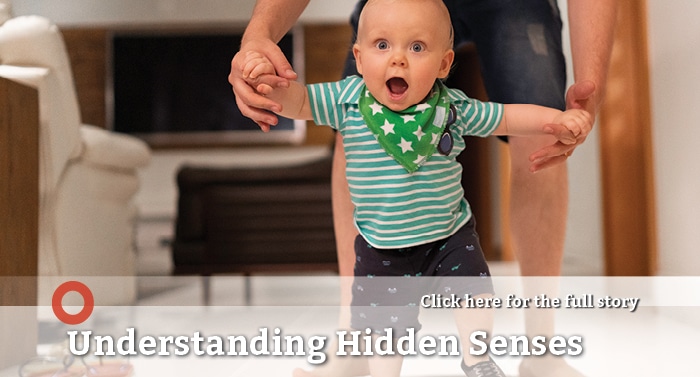Understanding Hidden Senses
By Mikaela Lyding, M.O.T., OTR/L
Does your child struggle to pay attention in school or have a meltdown at the end of the day from working so hard to keep it together and being a “good kid”? Have you ever wondered if this struggle was something other than a behavioral challenge?
Jean Ayres, Ph.D., OTR, FAOTA wrote that “learning and behavior are the visible aspects of sensory integration.”1 Ayres defined sensory integration as “the neurological process that organizes sensation from one’s own body and from the environment and makes it possible to use the body effectively within the environment.”2 Sensory processing includes all eight sensory systems. Everyone learns about the five major senses in school: sight, sound, smell, taste, and touch. Less commonly known are the “hidden” senses: the vestibular and proprioceptive senses, as well as interoception. The vestibular sense, which is the sense of balance and gravity, is housed in the inner ear and provides awareness of where the body is in space. In addition, the proprioceptive sense, which contributes to body awareness, has receptors located in the muscles and joints. Last, interoception refers to the internal processes of the body and their associated sensations.
Sensory processing development starts in the womb and continues rapidly throughout childhood. When presented with a sensory experience, the brain takes the information from the child’s body, the environment, and the sensory stimuli and organizes it for the next encounter. For example, as babies learn to pull up to stand and creep along furniture, they are preparing their sensory systems for the next step of walking. They are activating their proprioceptive sense when they bear weight on their legs, as well as their tactile sense with the feel of the ground, and their vestibular sense as they learn to move in a new way and sense gravity. Babies’ sights and sounds may change now that they are upright, and that gives them the inner drive to explore more and continue to develop their sensory systems. These neurological changes are an adaptive response.
Sometimes, as children develop, they may experience differences in their sensory processing, which can make seemingly little things difficult and can turn small problems into big meltdowns. Some examples of poor sensory integration include:
- Sight
- Sensitivity to bright lights, especially in a grocery store or with strobe lighting
- Constantly wanting to watch objects move, such as cars passing by or a video game
- Sound
- Poor tolerance of loud or unexpected noises, such as a fire alarm
- Making a noise happen again and again, such as the crash on a video game or slamming a door
- Smell
- Picky eaters who refuse food as soon as they smell it
- Hypersensitivity to odors
- Touch
- Overly sensitive to being touched by others
- Sensitivity to the feel of new clothing, or a dislike of certain fabrics
- Difficulty wearing socks or shoes
- Poor tolerance of bath time, teeth brushing, hair brushing, and haircuts.
- Gustatory
- Picky eaters
- Gagging on foods
- Vestibular
- Avoids swings, slides, and climbing activities during play
- Car sickness
- Constantly on the move, spinning and whirling the body around.
- Proprioceptive
- Clumsiness
- Continually bumping into people or things when walking or standing in a line
- Frequent falls
- Leaning on the person next to her/him when sitting down.
Children who show any of the above signs may have difficulty with sensory processing. Early identification, evaluation, and treatment by an Occupational Therapist is important for improving sensory integration and providing children with the best opportunities for success.
The information contained in this article is not intended to be a substitute for professional medical advice, diagnosis, care, or treatment. Always consult a qualified healthcare provider with any questions regarding any possible medical condition.
Mikaela Lyding, M.O.T., OTR/L is a registered and licensed Occupational Therapist and Clinical Assistant Professor for the Occupational Therapy Program at Midwestern University in Glendale, Arizona. The Occupational Therapy team at the Midwestern University Therapy Institute utilizes the latest technology and research to evaluate and help children develop their abilities, at affordable prices. Call 623-537-6000 to schedule an appointment. www.mwuclinics.com/az
References
- Ayres, A. J. (2005). Sensory integration and the child: Understanding hidden sensory challenges. Los Angeles, CA: Western Psychological Services.
- Bundy, A. C., Lane, S. J., & Murray, E. A. (2002). Sensory integration: Theory and practice. Philadelphia: F.A. Davis.
Other articles from the team at Midwestern University:
Virtual Speech-Language Therapy
Get To Know Midwestern University Clinics

